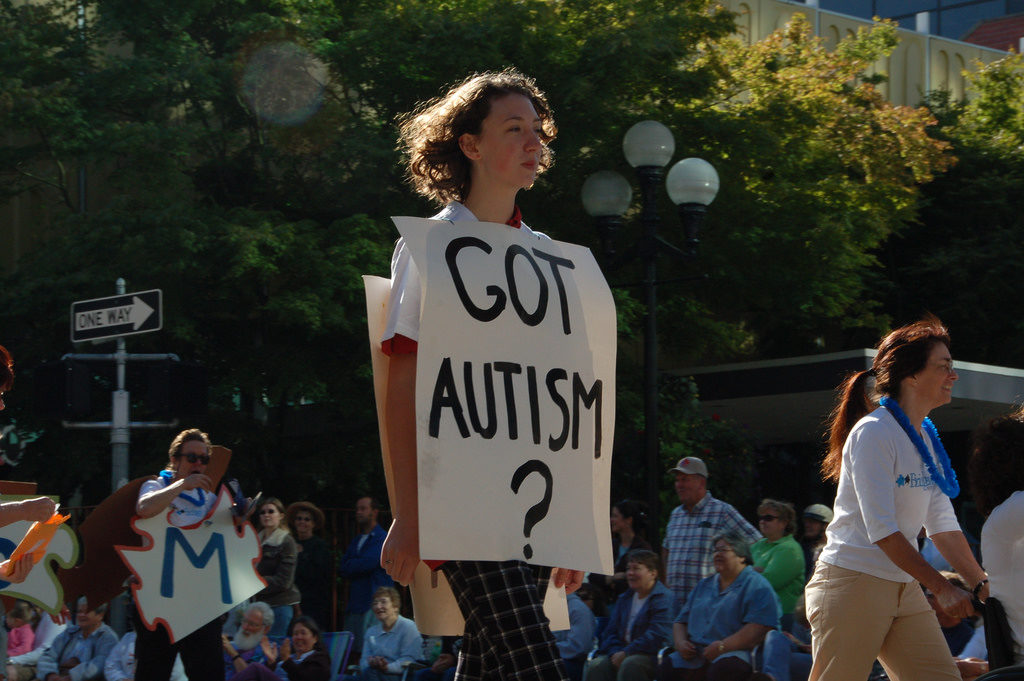
It is well known within the scientific community that individuals with autism spectrum conditions (autism hereafter) present higher levels of mental health needs. We have robust evidence now from large studies (population representative or total population studies) that mental health needs are present in autistic children at significantly higher levels compared to children who are neurotypical or have other developmental disabilities (Totsika et al., 2011; Simonoff et al., 2008). The same is true for adults with autism (Rydzewska et al., 2018). Robust data on the number of adolescents and young people with autism who also have mental health needs are lacking, however it would not be a big leap to assume that this group also have disproportionately high levels of mental health needs.
What is a lot less clear, however, is the experience of accessing mental health services: from realising the need for support to the actual receipt of clinical and other services. Evidence from research on children suggests a high level of unmet need: those with autism and mental health needs are not accessing the specialist mental health services they require (Chiri et al., 2012). Lack of services might be one of the reasons for lack of access, but the picture is more complicated than this. This is especially true where those who need support are at the cusp of child and adult mental health services.
In fact, transitioning from child and adolescent mental health services (CAMHS) to adult mental health services (AMHS) is a complex process. National guidance is available to describe good practice, but there is also evidence that young people with neurodevelopmental disabilities (such as autism) and affective disorders (such as anxiety) are less likely to move from CAMHS to AMHS (Islam et al., 2016).
The study I consider in this blog, by Laura Crane from the Centre for Research in Autism and Education and her colleagues (2018), seeks to further our understanding of how young autistic people experience the world of service provision in relation to their mental health needs, and in particular at the time of transition from child to adult services.
Crane and colleagues set off to address two research questions:
- What were young autistic people’s views and experiences of mental health services?
- How to best support young autistic people who are experiencing mental health problems?

How do we best support young autistic people who have mental health needs?
Methods
To address the research questions, two methods of data collection were used: an online survey of 109 individuals who self-reported as being autistic and were 16-25 years of age, and semi-structured interviews of 21 young autistic people in the same age range. Both methods used similar (convenience sampling) inclusion criteria and sampling approaches – participants opted in, responding to advertisements on social media and via existing databases (this is an example of convenience sampling, also known as non-probability sampling or opportunity sampling).
Whilst not representative of the population, participants were a fairly homogenous group of mostly educated, White British, 16 to 26 year-olds who had received their autism diagnosis around 13 to 14-years-old, with the majority (81%) having experienced mental health needs. Anxiety was the mental health condition most frequently reported.
Results
Key findings from the survey set out by Crane and colleagues were that:
- Slightly over half of those who experienced a mental health need (57%) could differentiate their autism symptoms from their mental health symptoms. The rest either couldn’t or were unsure.
- 90% had sought support from clinical services for their mental health, but levels of satisfaction were about 37% (for finding the service extremely/very useful). Fewer people had accessed support from charities/non-profit organisations and overall satisfaction was about 40%: these satisfaction figures are not that dissimilar.
- Only 10% had confidence with regard to accessing formal support for mental health needs. This is interesting considering that 81% of participants had already experienced mental health needs and accessed formal services.
- Lower quality of life (on standardised measures) compared with population norms.
From the interviews, Crane and colleagues found:
- Interviewees were not always clear on the distinction between autism symptoms and mental health symptoms, and would have liked more support in this area so as to be better prepared to recognise onset of mental health needs.
- Barriers to service access was by far the richest data stream, highlighting an overall negative experience accessing, or using services, and/or making the transition from CAMHS to AMHS, including: delays and long waiting lists; mental health services not understanding autism; precarious funding for service access; perceived pressure to be discharged quickly; and discontinuity in service experience when moving for university. One of the most prominent barriers was the different set-up between CAMHS and AMHS. AMHS is not simply an extension of child services but a different environment with different criteria for service access: AMHS responds to crisis or severe mental health needs and many people in this group were concerned how they would cope given they were not ‘severe enough’ to qualify for AMHS. When available, adult services expected more individual responsibility for the management of mental health which young autistic people did not necessarily want to assume.
- Whether services are provided by professionals or peers, these need to be specialised: autistic participants were clear that neither approach can be effective unless people are properly trained in mental health and autism.

Autistic people with mental health needs are clear that they need specialised services and these can only be effective if people are properly trained in both mental health and autism.
Conclusion
The authors conclude that we need to listen to the voices of autistic people when designing and delivering mental health services. Findings here highlithed that young autistic people are finding it difficult to identify their mental health needs, and when they do, accessing support is a challenge, especially accessing services where support is person-centred, and staff are knowledgeable about autism.

The authors conclude that we need to listen to the voices of autistic people when designing and delivering mental health services.
Strengths and limitations
It may come as a surprise to hear at this stage that this study followed what the authors refer to as a community-based participatory-research (CBPR) approach. In short, the study was co-produced between two groups of experts: young people with experience of autism and mental health needs, and researchers with understanding of developmental disabilities. Co-production is a big issue nowadays, and actually has been for a while (think participatory research – as a philosophical standpoint with several paradigms). My impression, though, is that the stakes have been raised over the past few years. Research funders and community stakeholders are keen on co-production, both motivated by a desire to make research more relevant to the people with whom it is concerned, and more impactful. There is an expectation we need to move beyond paying lip service to stakeholder engagement to ensuring that power is shared, responsibility is shared, and the outcome is real. In my opinion, this study is a trailblazer in this era of co-production. It is done so seamlessly that co-production is the least important thing about this study; it is an important dimension for the message the study carries, but not the only important characteristic about the study.
This level of sophistication in co-production is something to admire and an inspiration to the rest of us. I am sure it’s the product of many years of hard work. I am not glossing over the limitations of the study (there are plenty and the authors do a good job discussing these) and other Elf blogs also discuss them, but I take away the effective sharing of the research process among partners, and the use of mixed methods: this was not just another ‘lived experience’ study.

This study is a trailblazer in this new era of co-production. It is done so seamlessly that co-production is the least important thing about this study.
Implications for practice
Combine the study findings with the CBPR approach and one message is louder than others: all I can hear is ‘unmet need’ being shouted from both sides of the fence. How many more messages like this do we need before we do something about it?
The findings from this study have implications for researchers, service providers, commissioners, service managers, parents and young autistic people. But, for me, the first thing that needs to happen is we all need to sit down together and discuss how to re-design our support systems so that young adults with neurodevelopmental disabilities can get on with living their lives.

“All I can hear is ‘unmet need’ being shouted from both sides of the fence”: Vaso Totsika on young autistic people with mental health needs.
Conflict of interest statement
None
Links
Primary paper
Crane L, Adams F, Harper G, et al. (2018). ‘Something needs to change’: Mental health experiences of young autistic adults in England (PDF). Autism. 2018 Feb 23:1362361318757048.
Other references
Totsika V, Hastings RP, Emerson E, et al. (2011). Behavior problems at 5 years of age and maternal mental health in autism and intellectual disability. Journal of Abnormal Child Psychology. 1;39(8):1137. [Abstract]
Simonoff E, Pickles A, Charman T, et al. (20018). Psychiatric disorders in children with autism spectrum disorders: prevalence, comorbidity, and associated factors in a population-derived sample. Journal of the American Academy of Child & Adolescent Psychiatry. 1;47(8):921-9. [Abstract]
Rydzewska E, Hughes-McCormack LA, Gillberg C, et al. (2018) Prevalence of long-term health conditions in adults with autism: observational study of a whole country population (PDF). BMJ open.1;8(8):e023945.
Chiri G, Warfield ME (2012). Unmet need and problems accessing core health care services for children with autism spectrum disorder. Maternal and child health journal. 1;16(5):1081-91. [Abstract]
Islam Z, Ford T, Kramer T, et al. (2016). Mind how you cross the gap! Outcomes for young people who failed to make the transition from child to adult services: the TRACK study (PDF). BJPsych bulletin. 40(3):142-8.
Photo credits
- Feature Image:Photo by Jurica Koletić on Unsplash
- Caption 1: Josh Ward on Flickr (CC BY 2.0)
- Caption 2: Photo by Priscilla Du Preez on Unsplash
- Caption 3: Photo by Rawpixel.com at Freepik.com
- Caption 4: Photo by “My Life Through A Lens” on Unsplash
- Caption 5: Photo by Oleg Laptev on Unsplash
